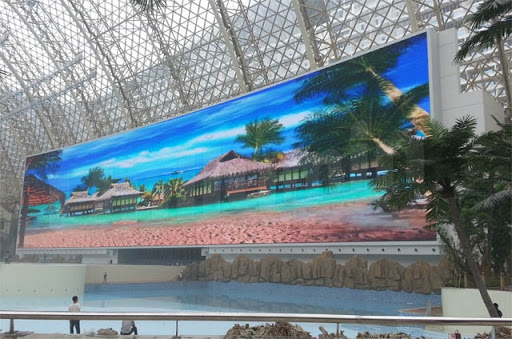The P10 LED display is an immensely powerful tool for control over the lighting, display space, or interactivity of any commercial or private space. Any indoor or outdoor location can be improved through the addition of P10 LED modules, whether through a simple retrofit or through inclusion in the space's initial design. The LED P10 module can add energy, excitement, and functional utility to any space—this article will tell you everything you need to know about this technology.
The standard part used in building any exciting LED display for commercial or home use is the P10 LED display. The P10 LED display is an array of 512 high-intensity LEDs arranged in a rectangular pattern on a plastic backing. Each screen has a matrix of 32 LEDs per row and 16 LEDs per column, and each of these hundreds of LEDs can be actuated independently in order to create a variety of exciting multicolored and moving displays and patterns. Each LED can also vary in brightness, giving you total control over the output display of the P10 module.

The P10 LED display screen has excellent technical specifications. With a 20-watt maximum power load and 5-volt direct current voltage input, the P10 LED display can output 3500 to 4500 nits of brightness. The P10 is especially useful for application as floor or wall tiles, as it can be viewed from a high angle, has dramatic contrast between LEDs of different colors, and is rated waterproof to IP65 regulations. While the standard P10 LED display generates colors using red, green, and blue lights, the P10 full color LED display screen achieves an even greater range of colors through more base colors for a more complete experience.
The P10 LED display is an immensely versatile tool for application across a wide variety of industries and fields, and can be used for serious industrial applications. Examples of this include mining enterprises, where a P10 LED panel can be used to illuminate walkways, provide bright directed light, or reflect sensor information on air quality or other important safety regulations. In any sort of factory, an array of P10 LED panels can be used for similar purposes, guiding workers around the factory floor or displaying important information on the factory's walls.
The P10 LED display can also be used in many applications relating to transportation. Public metro or subway stations can use P10 LED panels to display route information or timetables. Wharves can apply P10 LED panels to supplement sunlight and extend working hours, or direct crews more efficiently to their desired locations. Airports can use P10 LED technology in a similar fashion to the previously mentioned applications, for providing information or routing to busy customers. In addition, P10 LEDs can be used in airports to direct aircraft along their landing strips, improving safety and efficiency in aircraft takeoff and landing sequences.
In the public sphere, P10 LED panels have several applications. Billboards or other large advertising displays can use P10 LED modules in place of traditional printed advertisements in order to fit more customers within the same advertising space. P10 LED modules can be programmed to display a series of rotating advertisements, rather than just a single static one, allowing for more utility out of a single billboard. They also illuminate themselves, allowing for superior functionality during the night. City architects can incorporate P10 LED panels into their designs in new buildings, whether to attract customers or simply add a unique flair to the city's skyline. Public officials can also incorporate P10 LED modules into public and community events; for example, a fireworks show can be supplemented with P10 LEDs for lighting and displays as the sky darkens before the show can begin.
Finally, there are several other applications of the P10 LED system that are worth mentioning. A modern gymnasium can use these LEDs to inspire customers or to generate an interactive workout session. Similarly, schools can incorporate this system into classrooms for an interactive learning experience.
The P10 LED display screen is excellent for outdoor applications due to its high brightness and contrast between colors, allowing for crisp viewing even from far away and during bright daylight. In addition, the P10 LED display screen has a waterproof rating, making the P10 outdoor full color LED display an excellent option for all climates. Common potential applications of the P10 outdoor LED display include public works projects, transportation hubs, roadside billboards, and more!
There are many ways to install your own P10 LED display. The P10 LED display is generally 6 inches thick so it is robust enough to stand on its side and project light horizontally - a "standing type" installation. A variant on this is to use the robustness of the standing P10 LED module as a support for some other structure, a "supporting type" installation. These applications are superior for illumination at low heights.
P10 LEDs can also be arrayed in a grid with one another for many applications, such as an interactive LED floor. With a border and ramps for security and stability, this is an "inlaying type" of installation. P10 LED modules can also be hung up from the ceiling or walls, for either an LED ceiling or points of spot illumination in the "hanging type" installation. Evidently, P10 LED panels are excellent for use on full floors or ceilings; in addition, they can be mounted on walls to cover an entire wall in this way, a "wall mounting type" of installation. If you have windows that you want to remain uncovered, you can also install just columns of P10 LED modules in this way, in a "pillar type" installation.
This concludes our discussion of P10 LED displays. Now that you know all of the specifics and benefits of this technology, you are ready to incorporate it into your own business or home. There are countless ways to use the P10 LED display, so be creative!